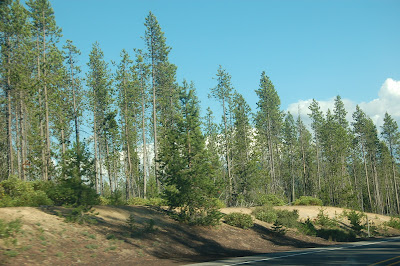Links go to FlashEarth permalinks, which should give you nice, accurate location info. The Ponderosa Pine stretch is not very well represented along highway 58, and not at all in my photos, so I've included a few farther out into central Oregon. However, it's pretty amazing how many diverse habitats fit well within this particular range. (With exception of photo near Klamath Lake)
DSC0010
DSC0011
Forest at Salt Creek Falls, Oregon (DSC0010) and Salt Creek Falls (DSC 0011) - Just west of Willamette Pass, guestimate this area gets ~125-150 inches of liquid equivalent precipitation per year, much in the form of snow.
DSC0025
Diamond Peak Veiwpoint, (DSC0025) Forest and Meadow- Very close to crest now, (drag just a bit east and you'll see the Willamette Pass Ski Area, which sits right on the divide) lots of heavy snow. Doug Fir still dominant, but not as big, has a harder time colonizing as shown by meadow.
DSC0030
Coming down the east side from the pass (DSC0030), FE location is approximate. Pass is 5128 feet, sign on left side of road notes 5000 foot elevation. Still Douglas Firs, but definitely smaller and more spindly, and undergrowth is not as lush.
DSC0035
DSC0036
DSC0042
Looking back toward Cascade Crest (DSC0036), Odell Butte cut off on right side of photo. Lodgepole pine dominant, underbrush mostly grasses and very scrubby. Better view of vegetation (DSC0042). Yellow-tan layer is Mazama tephra. (and added in a followup email, "Actually meant to include DSC0035 as well- 'Yellow-tan layer is Mazama tephra' doesn't make much sense without it.")
DSC0046
Near Klamath Lake (DSC0046) (FE location approximate).
DSC0417
Fort Rock, Oregon (DSC0417) - no trees at all. Grasses, sage brush and rabbit brush (Forgot to mention it in my note, but again, rough guestimate, I'd say in the range of 15-20 inches of precipitation annually in this area... Hmm. Just Googled it and found this: "The mean annual precipitation is 200 to 300 mm," so closer to 8 to 12 inches annually.)
DSC0425So there you have it. As I commented in my previous post, "...even if you know nothing about the rocks, even if you know nothing about what types are around, or what processes formed them and put them where they are, the simple fact of two enormous piles of them in parallel north-south ridges have a profound effect on us here in western Oregon." There's no better way to appreciate this than to drive across the Cascades and out just a little way into the High Desert. I've read it's one of the fastest ecological gradients in the world. I'm always skeptical of any source that claims world's most extreme anything, and I won't vouch for that claim. Nevertheless, it's pretty danged impressive to drive in an hour or so from an area that gets well over a hundred inches of rain a year to an area that gets a tenth of that.
DSC0433
DSC0436
Forest near Hole-in-the-Ground, Oregon (DSC0436)- this spot is about 1000 feet- maybe less- higher than Fort Rock, but gets enough more precip to support a nice ponderosa pine forest. And finally, forgot about this one, also at Hole-in-the-Ground (DSC0433). This is the south end of this maar, where the angle of the wall and shade mean water doesn't evaporate as fast, so the pines can at least germinate and grow, if not exactly thrive. In north side of crater, trees don't do well at all (DSC0425)
(And yes, of course, anyone who wants to use these for educational purposes is welcome to. I'm not sure how much size & resolution they lose being posted to and downloaded from Blogger, but if you'd like full size photos (2000 by 3000 pixels), drop me an email)





















No comments:
Post a Comment